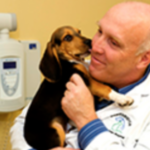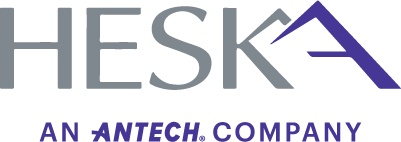Ultrasonography and Intestinal Foreign Body
To cut or not to cut…..making a diagnosis more reliable.
One of the most frustrating decisions that may be required of the veterinarian is confirmation of whether or not an animal is a surgical case. Never is this truer than with the possible foreign body. How many veterinarians have performed an exploratory laparotomy convinced that there was an intestinal obstruction only to find there was none? Compound this with having to inform a client that surgery might potentially have been avoided, and then perhaps taking a financial loss as we discount our fees. How can we best avoid this pitfall? Wouldn’t it be to our advantage to have a diagnostic tool to verify our suspicions of a foreign body with greater certainty than with radiographs or barium alone?
Ultrasound can dramatically assist the practitioner in management of these cases.
Let’s analyze the following scenario. An animal comes into your office for a 2 PM appointment with a history of vomiting and some lethargy for 24 hours. An abdominal palpation reveals some tenderness. Ileus may also be noted on auscultation. You decide to run both bloodwork and abdominal radiographs. If you have a biochemistry/CBC analyzer in house you will probably have results within an hour of admission. It is now 3:30 PM. The first radiographs are not very revealing so you decide to run a barium series. You spend time on the phone discussing the initial test results and receive permission to proceed. The barium is given at 4:30. Gastric, duodenal and then jejunum images are obtained over time but due to the ileus the flow of barium is slow. 6:45 Pm and you feel that an exploratory laparotomy is recommended. At this point you and your staff are about to end your regularly scheduled day. Neither you nor the owner is comfortable leaving the pet until the next morning so you recommend transfer to an emergency hospital. The owner is disappointed that the condition couldn’t be diagnosed earlier and you have forwarded all your potential surgical, anesthesia and hospitalization services to another facility. In a worst case scenario they perform surgery at the referral hospital and find nothing. Sound familiar?
Let’s bring ultrasound into the scenario.
More often than not, ultrasound is our first line of investigation when dealing with abdominal cases. At the time of the initial bloodwork we place an ultrasound probe on the abdomen. We look for a fluid filled pocket especially in the jejunum. Within 5 to 10 minutes depending on the size of the animal a distended loop of bowel is found. The motion of the contents within the bowel is strongly suggestive of the presence of an obstruction. We follow the jejunum in both directions. As the lumen becomes more and more distended it is tracked until the sonography detects a blockage. We can potentially confirm a blockage within 20 minutes. At this point you recommend a laparotomy to the owner, potentially starting by 4 PM. And, since your images direct exactly where to incise the abdomen the surgical time is reduced. Potentially surgery is complete by 6 and the animal is on it’s way to making a full recovery.
The time difference between running a barium series and doing an ultrasound examination is huge. This time can be crucial to the patient. For example; radiographs below were suspicious for a linear foreign body so an ultrasound was performed. Note the apparent plications in the cranial ventral abdomen circled in green on the right image.

The ultrasound image clearly outlined the classic appearance of a linear foreign body. Surgical images taken from the same patient are representative of the ultrasound findings.

Sometimes we will create 3D versions of the exam in order to better explain to the owner the diagnostic imaging findings and their implications. The following collage of images presents the 3D format on the left. The next two images are from a dorsal reconstruction of the digital data. The foreign body can be seen in the lumen as a bright hyperechoic echo. You can almost perfectly match up these plications with those on the gross surgical images. This clearly shows the diagnostic capability of ultrasound over a barium series in this case, with the benefit of the much shorter time frame.

Sometimes the shape of the foreign body is a giveaway. The following images are examples of an unusual 90 degree angle made by the obstructing object. This was identified at the point where the distension of the bowel abruptly ended. Many of these objects are found in the first third of the jejunum. With ultrasound we can identify which section of either the small or large intestines that are being scanned. The study can clearly differentiate between stomach, duodenum, jejunum, ileum, cecum and all three parts of the colon (ascending, transverse and descending).
 In some cases we never get to see an object on abdominal radiographs due to its composition and lucency. Ultrasound is less limited by this. When searching for a diseased loop of bowel it will often be isolated by the presence of reactive surrounding fat that appears as hyperechoic on ultrasound studies. Think of it as being very reactive fat. This also happens when neoplasms create a localized partial outflow obstruction in the gut. The images below are of a cat diagnosed with an obstruction and taken to surgery within an hour of admission. The thick rubber bands apparently tasted like a lobster feast!
In some cases we never get to see an object on abdominal radiographs due to its composition and lucency. Ultrasound is less limited by this. When searching for a diseased loop of bowel it will often be isolated by the presence of reactive surrounding fat that appears as hyperechoic on ultrasound studies. Think of it as being very reactive fat. This also happens when neoplasms create a localized partial outflow obstruction in the gut. The images below are of a cat diagnosed with an obstruction and taken to surgery within an hour of admission. The thick rubber bands apparently tasted like a lobster feast!

The images below are of a foreign body that was identified in the ascending colon. No surgery was required.

Below is an example of a large intestinal mass restricting passage of fecal balls within its lumen. Note the hyperechoic mesentery in the left far field area which contains the vasculature. It acted as a sentinel to identifying potential pathology.

These are just a few examples on why ultrasonography can and should become an essential diagnostic tool with respect to the management of hospitalized cases that you encounter on a daily basis. Hopefully this brief article has stimulated your interest in seeing some of the unlimited potential this imaging tool can add to your practice. Join us at our next “Pearls of Ultrasonography” course offered through SCIL education where we discuss many of these conditions in greater depth.

